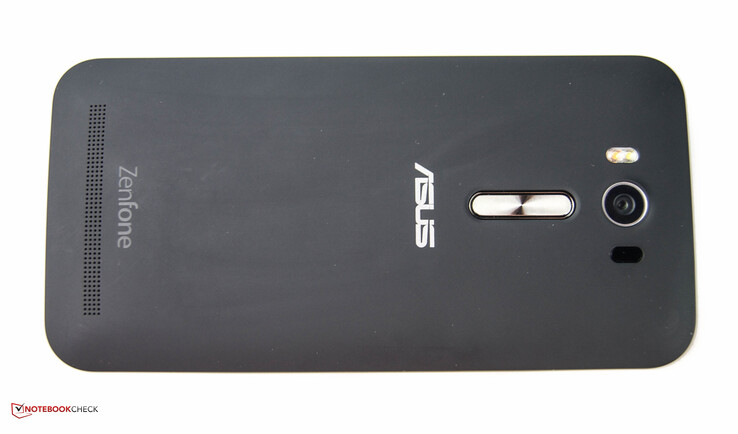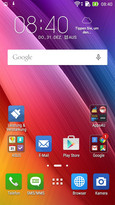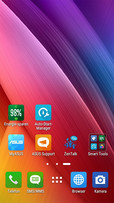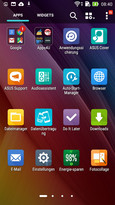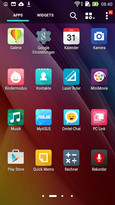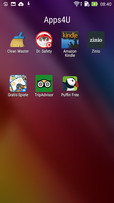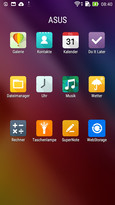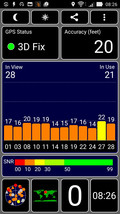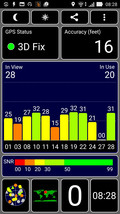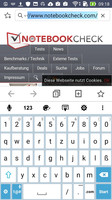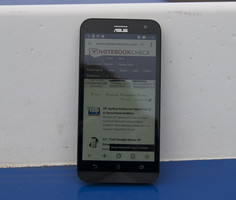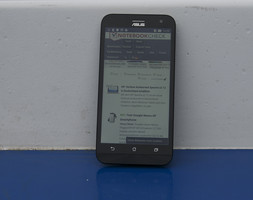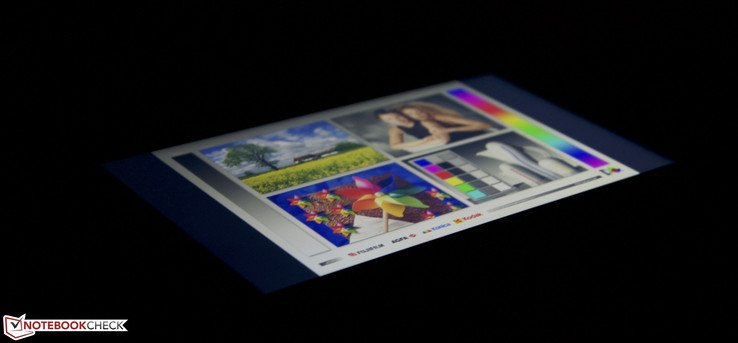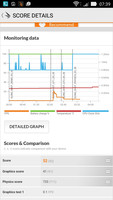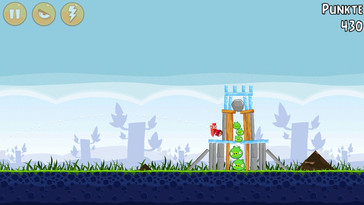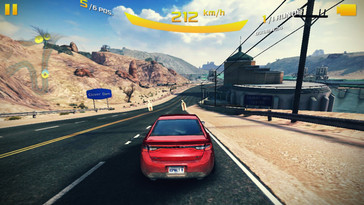Asus ZenFone 2 Laser ZE500KL Smartphone Review

For the original German review, see here.
The ZenFone 2 Laser (ZE500KL) appears in an elegant design, and aims to place itself in the upper mid-range. Equipped with a 5-inch screen and Corning Gorilla Glass 4, it attempts to discourage the competition with its robustness. It comes with a Snapdragon 410 SoC processor, 2 GB of working memory, a 16 GB flash memory, dual-SIM support, and Lollipop (Android 5.0) operating system. This total bundle is currently available for 230 Euros (~$250) in seven different colors.
We consult worthy rivals for validating the qualities of our review sample. Motorola's Moto G steps in with a similar configuration for 250 Euros (~$272). Samsung's Galaxy J5 is in the same price range as our smartphone. We add the stronger and also 40 Euros (~$44) more expensive OnePlus' X based on a Snapdragon 801 for testing the processor's power.
Case
Asus presents the ZenFone 2 Laser as highly robust and intricately processed. Thanks to the use of Corning Gorilla Glass 4, the 5-inch display should withstand drops from one meter (3.3 ft). The contrast between the glossy front and the matte, rubber-coated back looks very elegant. However, we have to deduct points here: The back cover's surface is soon covered with minor signs of use. Therefore, not only the device no longer looks as good, it also looks much older than it actually is after just a few days.
Moreover, we doubt the generously advertised robustness of the smartphone due to the plastic build. Furthermore, during closer inspection, we noticed slight irregularities in the transition of the front and back parts.
Unlike the rivals' slim build, Asus now relies on a curved casing with rounded corners. This is to provide some grip, making it safe to hold the handset. However, we find it rather too slippery due to the back's sleek surface.
There are no buttons on the sides apart from the power button on the upper edge. Thus, Asus could achieve a slim 3.5 millimeters (~0.14 in) on the sides as well as a flyweight of 140 grams (~5 oz). Volume control button is situated on the back and the 13 MP camera is situated directly beside it. A second 5 MP camera is installed on the front.
The removable back cover is an important feature that allows battery replacement. Both SIM card slots and the micro-SD card slot can be accessed after removing the battery. The storage can be expanded to 128 GB.
Connectivity
The limited interface diversity is not surprising: a USB 2.0 port on the lower edge and an audio jack on the upper edge. Although many smartphones support USB OTG for connecting a mouse or keyboard, our review sample only identified storage devices. App2SD is supported, making it possible to move apps to the memory card. The ZenFone also features two SIM card slots for dual-SIM operation.
Software
Asus' ZenFone 2 Laser is equipped with Android 5.0 (Lollipop). In addition to the software, we also find some third-party software on the review sample. However, they can be uninstalled if not needed.
It has to be mentioned that this is not the latest Android version on the market. We will have to wait and see if Asus will be providing an update here.
Communication & GPS
More than one communication option is installed. Firstly, via a Wi-Fi connection that supports the 802.11 b/g/n standard. Devices can also communicate via a Bluetooth 4.0 connection. However, probably the most important medium is mobile data transmission. Up to LTE C4, which can theoretically achieve download rates of 150 Mbps (up: 50 Mbps) is used.
Localization is possible via the installed GPS module. Multiple standards are available for this (GPS, GLONASS, AGPS, and BDS). It takes some time for connecting indoors, but a strong and stable reception quality is achieved within a few seconds outdoors.
Telephone & Call Quality
The test call reminds us of an old analog connection. It sounds as if the person is far away. However, the contact hears a good voice quality, and the installed speaker renders speech clearly.
Cameras & Multimedia
A 5 MP camera for selfies and snapshots is installed on the front. It fulfills its purpose. The rear-facing 13 MP camera definitely ensures better quality. It produces color-rich photos alongside the auto-focus and LED flash. A relatively good photo quality can be seen based on our example pictures. In sufficiently bright surroundings, the familiar color noise occurs late.
Accessories
In addition to the instructions, a charging cable and headset are included. The manufacturer also offers some interesting items on its page: A dual-LED flash (LolliFlash) for improving the picture quality are presented in different colors. Beyond that, a flip cover and in-ear headsets can also be purchased.
Warranty
A 24-month warranty with pick-up and return service from date of purchase is included. Unfortunately, no further information about warranty or other optional upgrades are found on the manufacturer's page.
Input Devices & Handling
Asus uses its own virtual keyboard. The user can create a dictionary so that personal abbreviations are also displayed in word suggestions, making it easier to type. Impressive: Handwriting is also detected. The thickness can be adjusted, but this function can only be used in special apps (SuperNote). The keys are large in both landscape and portrait mode. The available space is used perfectly. We could type quickly and smoothly.
Display
The stable 5-inch HD panel has a resolution of 1280x720 pixels. This equates to a pixel density of 294 PPI. Seen purely subjectively, the brightness looks rather dimmed. However, it reaches a very good rate of 460 cd/m² in the tests. It will be seen whether this dimming is caused by a grayish tint further below.
By comparison: Samsung's Galaxy J5 with the same pixel density cannot outshine our handset with its brightness of 353 cd/m². It looks even worse for the Full HD panel in OnePlus' X.
| |||||||||||||||||||||||||
Brightness Distribution: 95 %
Center on Battery: 467 cd/m²
Contrast: 1557:1 (Black: 0.3 cd/m²)
ΔE ColorChecker Calman: 3.28 | ∀{0.5-29.43 Ø4.79}
ΔE Greyscale Calman: 1.89 | ∀{0.09-98 Ø5}
Gamma: 2.21
CCT: 6734 K
| Asus Zenfone 2 ZE500KL Adreno 306, 410 APQ8016, 16 GB eMMC Flash | OnePlus X Adreno 330, 801 MSM8974AA, 16 GB eMMC Flash | Motorola Moto G 3. Gen 2015 XT1541 Adreno 306, 410 MSM8916, 8 GB eMMC Flash | Samsung Galaxy J5 Adreno 306, 410 MSM8916, 8 GB eMMC Flash | HTC Desire 626G dual sim Mali-450 MP4, MT6592, 8 GB eMMC Flash | |
|---|---|---|---|---|---|
| Screen | -99% | -36% | -44% | -72% | |
| Brightness middle (cd/m²) | 467 | 312 -33% | 418 -10% | 349 -25% | 497 6% |
| Brightness (cd/m²) | 460 | 314 -32% | 407 -12% | 353 -23% | 483 5% |
| Brightness Distribution (%) | 95 | 91 -4% | 95 0% | 93 -2% | 90 -5% |
| Black Level * (cd/m²) | 0.3 | 0.49 -63% | 0.67 -123% | ||
| Contrast (:1) | 1557 | 853 -45% | 742 -52% | ||
| Colorchecker dE 2000 * | 3.28 | 6.28 -91% | 3.92 -20% | 5.22 -59% | 6.88 -110% |
| Greyscale dE 2000 * | 1.89 | 8.24 -336% | 3.81 -102% | 3.96 -110% | 6.11 -223% |
| Gamma | 2.21 100% | 2.12 104% | 2.27 97% | 2.08 106% | 1.78 124% |
| CCT | 6734 97% | 8145 80% | 7361 88% | 7308 89% | 6820 95% |
| Color Space (Percent of sRGB) (%) | 86.5458 |
* ... smaller is better
Subjectively, black looks relatively saturated as long as the brightness is not at maximum. The black level of 0.3 cd/m² also confirms this, and can be considered quite good. The resulting contrast not only ensures good rates in the specification sheet, it also produces nice and strong images on the screen. Motorola's handset cannot keep up with its black level of 0.49 cd/m² in this case, either.
We examine the deviations in colors and grayscale via the CalMAN analysis. A good rate of 1.89 is ascertained in the grayscale levels in factory state.
The colors present 3.28, which place our review sample slightly above the average. The rivals look rather bad against that. Neither OnePlus' X (6.28) nor Samsung's Galaxy J5 (5.22) can compete with our review sample.
We measured a color temperature of 6734 K in our ZenFone. This rate only deviates slightly from the ideal (6500 K).
Performance
The ZenFone is equipped with a Snapdragon 410 SoC processor that clocks at 1.2 GHz and features four cores. In combination with the Qualcomm Adreno 306 GPU, it is situated in the mid-performance category. A 2 GB LPDDR3 memory supports that. A glance at the rivals shows that such a large memory is not a matter of course. Motorola's only has half the working memory.
Now for a look at the performance outcomes in the benchmarks: Overall, the installed SoC is on the expected level, and is almost on par with the equally built rivals. A glance at the clock rates in 3DMark reveals that the CPU clock rate never remains stable over ann extended period of time.
| Geekbench 3 | |
| 32 Bit Single-Core Score (sort by value) | |
| Asus Zenfone 2 ZE500KL | |
| OnePlus X | |
| Motorola Moto G 3. Gen 2015 XT1541 | |
| HTC Desire 626G dual sim | |
| ZTE Blade V6 | |
| 32 Bit Multi-Core Score (sort by value) | |
| Asus Zenfone 2 ZE500KL | |
| OnePlus X | |
| Motorola Moto G 3. Gen 2015 XT1541 | |
| HTC Desire 626G dual sim | |
| ZTE Blade V6 | |
| 3DMark - 2560x1440 Sling Shot OpenGL ES 3.0 (sort by value) | |
| Asus Zenfone 2 ZE500KL | |
| OnePlus X | |
| Samsung Galaxy J5 | |
| Motorola Moto G 3. Gen 2015 XT1541 | |
| Allview E4 | |
| GFXBench 3.0 | |
| on screen Manhattan Onscreen OGL (sort by value) | |
| Asus Zenfone 2 ZE500KL | |
| OnePlus X | |
| Samsung Galaxy J5 | |
| Motorola Moto G 3. Gen 2015 XT1541 | |
| Allview E4 | |
| ZTE Blade V6 | |
| 1920x1080 1080p Manhattan Offscreen (sort by value) | |
| Asus Zenfone 2 ZE500KL | |
| OnePlus X | |
| Samsung Galaxy J5 | |
| Motorola Moto G 3. Gen 2015 XT1541 | |
| Allview E4 | |
| ZTE Blade V6 | |
| Smartbench 2012 | |
| Gaming Index (sort by value) | |
| Asus Zenfone 2 ZE500KL | |
| OnePlus X | |
| Samsung Galaxy J5 | |
| Motorola Moto G 3. Gen 2015 XT1541 | |
| Allview E4 | |
| HTC Desire 626G dual sim | |
| ZTE Blade V6 | |
| Productivity Index (sort by value) | |
| Asus Zenfone 2 ZE500KL | |
| OnePlus X | |
| Samsung Galaxy J5 | |
| Motorola Moto G 3. Gen 2015 XT1541 | |
| Allview E4 | |
| HTC Desire 626G dual sim | |
| ZTE Blade V6 | |
Asus' ZenFone 2 Laser also proves competitive in the browser benchmarks. The results correspond with the subjective browsing speed. Occasional stutters cannot be avoided and only occur when opening more intricate pages.
| Sunspider - 1.0 Total Score (sort by value) | |
| Asus Zenfone 2 ZE500KL | |
| Samsung Galaxy J5 | |
| Motorola Moto G 3. Gen 2015 XT1541 | |
| Allview E4 | |
| OnePlus X | |
| Octane V2 - Total Score (sort by value) | |
| Asus Zenfone 2 ZE500KL | |
| Samsung Galaxy J5 | |
| Motorola Moto G 3. Gen 2015 XT1541 | |
| Allview E4 | |
| OnePlus X | |
| Mozilla Kraken 1.1 - Total (sort by value) | |
| Asus Zenfone 2 ZE500KL | |
| Samsung Galaxy J5 | |
| Motorola Moto G 3. Gen 2015 XT1541 | |
| Allview E4 | |
| OnePlus X | |
* ... smaller is better
Games
The installed hardware in Asus' ZenFone 2 Laser will not reach the peak of gaming performance. Nevertheless, casual games like "Angry Birds" are rendered smoothly. Games like "Asphalt 8 Airborne" are more difficult: Permanent micro-stuttering has to be accepted. Reducing the graphics settings to minimum when possible can remedy that.
Emissions
Temperature
We observe the review sample's temperature development while running the Stability Test for one hour.
Under load, only one hot spot reaches 41 °C (~106 °F). Otherwise, the rates remain constant with 31 to 35 °C (~88 to 95 °F). However, this scenario will rarely occur.
The smartphone remains uncritical with 30 °C (~86 °F) while idling. This is similar to the rivals.
(±) The maximum temperature on the upper side is 41.1 °C / 106 F, compared to the average of 35.2 °C / 95 F, ranging from 21.9 to 247 °C for the class Smartphone.
(+) The bottom heats up to a maximum of 37 °C / 99 F, compared to the average of 34 °C / 93 F
(+) In idle usage, the average temperature for the upper side is 27.8 °C / 82 F, compared to the device average of 32.9 °C / 91 F.
Speakers
The volume could be slightly higher, but that is the only complaint here. Otherwise, playback is very clear, making speech quite audible. It should definitely be enough for short videos or Skype calls.
Energy Management
Power Consumption
Restraint is the motto of the installed components. Hardly more than 4 watts are consumed even under load conditions. Thus, the ZenFone 2 Laser consumes less power than its virtually identically built rivals.
| Asus Zenfone 2 ZE500KL Adreno 306, 410 APQ8016, 16 GB eMMC Flash | Motorola Moto G 3. Gen 2015 XT1541 Adreno 306, 410 MSM8916, 8 GB eMMC Flash | OnePlus X Adreno 330, 801 MSM8974AA, 16 GB eMMC Flash | Samsung Galaxy J5 Adreno 306, 410 MSM8916, 8 GB eMMC Flash | |
|---|---|---|---|---|
| Power Consumption | -7% | -5% | -104% | |
| Idle Minimum * (Watt) | 0.5 | 0.4 20% | 0.6 -20% | 1.5 -200% |
| Idle Average * (Watt) | 0.9 | 1 -11% | 0.91 -1% | 2.2 -144% |
| Idle Maximum * (Watt) | 1.1 | 1.2 -9% | 1.12 -2% | 2.4 -118% |
| Load Average * (Watt) | 2.4 | 2.9 -21% | 3.04 -27% | 3.5 -46% |
| Load Maximum * (Watt) | 4.3 | 5 -16% | 3.2 26% | 4.8 -12% |
* ... smaller is better
| Off / Standby | |
| Idle | |
| Load |
|
Key:
min: | |
Battery Runtime
As mentioned before, the ZenFone is equipped with a removable lithium battery with a capacity of 2070 mAh. We performed our Wi-Fi test that simulates Internet browsing at a brightness dimmed to 150 cd/m² on our review sample. Surprisingly, we did not even manage 5 hours.
The competition outperforms our review sample in this regard. The three opponents are roughly on par. Samsung's handset starts with 8 hours 15 minutes, Motorola's device lasts half an hour longer, and OnePlus takes the lead with almost 9 hours.
| Battery runtime - WiFi v1.3 (sort by value) | |
| Asus Zenfone 2 ZE500KL | |
| Motorola Moto G 3. Gen 2015 XT1541 | |
| Samsung Galaxy J5 | |
| OnePlus X | |
Pros
Cons
Verdict
The ZenFone 2 Laser can certainly settle down in the mid-range. Its HD panel scores with strong colors and rich black. The smartphone's removable battery and storage expansion options hardly limit long-term use. We cannot complain much about the input devices, either. Fast typing and good responsiveness were impressive. The poor call quality has to be noted unfavorably. Besides that, the casing is very slippery and susceptible for signs of use.
The buyer could find a diligent, everyday companion in the ZenFone 2 Laser for little money.
However, power-conscious users should take a look at OnePlus' X.
Asus Zenfone 2 ZE500KL
- 01/05/2016 v4.1 (old)
Nino Ricchizzi




